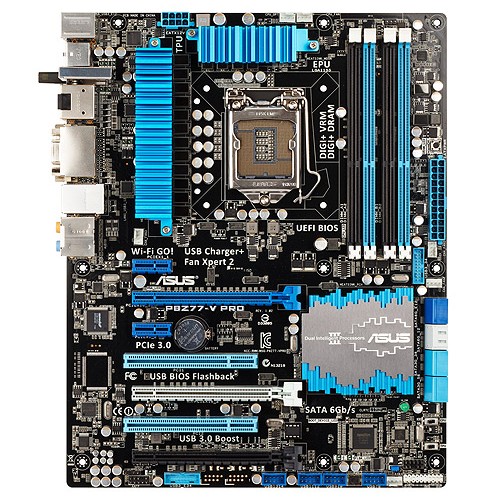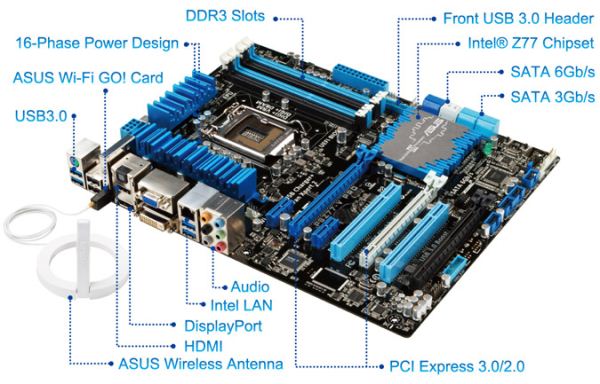Intel Z77 Panther Point Chipset and Motherboard Preview – ASRock, ASUS, Gigabyte, MSI, ECS and Biostar
by Ian Cutress on April 8, 2012 12:00 AM EST- Posted in
- Motherboards
- Intel
- Biostar
- MSI
- Gigabyte
- ASRock
- Asus
- Ivy Bridge
- ECS
- Z77
ASUS P8Z77-V Pro—Visual Inspection
ASUS have a lot to live up to with its Ivy Bridge Pro board. Both the ASUS P8P67 Pro and ASUS P8Z68-V Pro have been top class sellers in their respective chipsets, meaning that ASUS has to deliver. Thankfully, by just looking at the board, it seems that ASUS is keen to innovate and offer a complete package.
Using a 12 + 4 VRM power delivery system, the ASUS P8Z77-V Pro sports a blue and black livery synonymous with their channel / non-ROG products. The VRM heatsinks cover a lot of surface area in their jagged fashion, and around the socket itself, we have access to five main fan headers. Two of these are CPU 4-pin headers just north of the top VRM heatsink, one 4-pin below the left hand side VRM heatsink, and two 4-pin headers below the 24-pin ATX power connector, along with a USB 3.0 port. A sixth fan header (4-pin) is found on the south side of the board.

Above the 24-pin ATX power connector, we find the ASUS MemOK! button, which allows memory recovery to default speeds. Along with the ASRock boards, we have eight SATA ports—four SATA 3 Gbps from the PCH and four SATA 6 Gbps—two from the PCH and two more from an ASMedia controller. Below this are the TPU and EPU switches, designed for enhanced CPU performance and energy saving modes respectively.

Along the bottom of the board is the standard array of a front panel audio header, another USB 3.0 header, USB 2.0 headers, and a front panel header. In terms of PCIe layout, despite there being three full-length PCIe connectors on board, we are only limited to using two for multi-GPU setups. In order, we have a PCIe x1, a PCIe 3.0 x16 (x8 in dual GPU), x1, PCI, PCIe 3.0 x8, PCI, and a PCIe 2.0 x4. Thus in dual GPU mode, similarly to the ASRock Extreme6, we can also add in a PCIe x1 and PCIe x4 card.
The chipset heatsink is indicative of the large but low philosophy of many motherboard manufacturers, hiding away the chipset controller. What is not on these boards, as you may notice, is a combination power/reset pair of buttons, nor a two-digit debug, some of which we used to see on ASUS Pro boards of old. Nevertheless, the ASUS board in return makes up for it on the back IO panel.

On the back panel, we have a combination PS/2 port, two USB 3.0 ports (blue), two USB 2.0 ports (black), an ASUS Wi-Fi GO! Card, optical SPDIF output, HDMI, DisplayPort, D-Sub, DVI-D, gigabit Ethernet, two more USB 3.0 ports in blue, and standard audio headers.
This means that rather than add in a WiFi module on the board, or use up a mini-PCIe slot with wifi, we have a slot in order to add a WiFi module. This can be in 2.4 GHz or 5 GHz mode, and updateable as WiFi standards change. This all comes as part of the package, with magnetic wireless antenna to attach to the case.
Board Features
| ASUS P8Z77-V Pro | |
| Size | ATX |
| CPU Interface | LGA-1155 |
| Chipset | Intel Z77 |
| Power Delivery | 12 + 4 |
| Memory Slots |
Four DDR3 DIMM slots supporting up to 32 GB Up to Dual Channel |
| Video Outputs | DisplayPort, HDMI 1.4a, DVI-D, D-Sub |
| Onboard LAN | Intel 82579V |
| Onboard Audio | Realtek ALC892 |
| Expansion Slots |
2 x PCIe x16 Gen3 (x16, x8/8) 1 x PCIe x16 Gen2 (x4) 2 x PCIe x1 Gen2 2 x PCI |
| Onboard SATA/RAID |
2 x SATA 6 Gbps (PCH), Support for RAID 0, 1, 5, 10 2 x SATA 6 Gbps (ASMedia) 4 x SATA 3 Gbps (PCH), Support for RAID 0, 1, 5, 10 |
| USB |
Four USB 3.0 at rear (2 PCH, 2 ASMedia) Two USB 3.0 headers on board (PCH, ASMedia) Ten USB 2.0 (2 back panel, 8 on board) |
| Onboard |
4 x SATA 6 Gbps 4 x SATA 3 Gbps 2 x USB 3.0 Headers 4 x USB 2.0 Headers 6 x Fan Headers 1 x SPDIF Header 1 x Front Panel Audio Header MemOK! Button TPU/EPU Switches USB Flashback Button |
| Power Connectors |
1 x 24-pin ATX connector 1 x 8-pin 12V connector |
| Fan Headers |
1 x CPU Fan Header (4-pin) 4 x CHA Fan Headers 1 x OPT Fan Header |
| IO Panel |
1 x PS/2 Combo Port 1 x DisplayPort 1 x HDMI 1.4a 1 x DVI-D 1 x D-Sub 1 x Gigabit Ethernet 4 x USB 3.0 2 x USB 2.0 1 x Optical SPDIF 1 x WLAN Connector 6 x Audio Jacks |
| Warranty Period | 3 Years |
| Product Page | Link |
ASUS as a direct standard are now placing Intel NICs on all their channel motherboards. This is a result of a significant number of their user base requesting them over the Realtek solutions. Also to note are a total of six USB 3.0 on board, two on the back panel and four from internal headers. These USB 3.0 ports can take advantage of the improved UASP USB 3.0 protocol using appropriate hardware and some ASUS software. As always, we expect ASUS fan control of the six headers to be top notch.











145 Comments
View All Comments
t4murphy - Wednesday, April 18, 2012 - link
That was a good cpu for me before I went to the 920. I still ran MS FS9 with good results along with my GTX 8800. Im not laughing:)rocknrob - Thursday, April 12, 2012 - link
I had a 920 X58 setup and decided to rebuild to an i7 2700K Z68. So far I've regretted the whole thing. I'm going to pick up one of these ASUS Z77 Deluxe boards but I don't think it's going to make a big difference.The X58's/i7's were rock solid and performance monsters. I honestly see very little in terms of performance gains. Supposedly Ive Bridge processors are only going to give you about 15% to 20% increase in performance. If that's the case I think I'm going to stick with the 2700K until the next architecture change.
457R4LDR34DKN07 - Sunday, April 8, 2012 - link
you need to get a asus P8Z77-I DELUXE review.Mitxplease - Sunday, April 8, 2012 - link
Hells yes.GreenEnergy - Sunday, April 8, 2012 - link
I only found one (tiny) review sofar:http://vr-zone.com/articles/first-look-asus-p8z77-...
457R4LDR34DKN07 - Wednesday, April 11, 2012 - link
I actually would like a comparison with ZOTAC Z77-ITX WiFi, as I'm leaning toward the zotac mobo due to the msata compatibility by removing the wifi/bt module.ViperV990 - Sunday, April 8, 2012 - link
Does the Virtu MVP stuff work with an Eyefinity or NV Surround setup?martinw89 - Sunday, April 8, 2012 - link
I'm very curious about this too. On page two, Ian says "Within the hybrid system, the integrated GPU takes over two of the tasks for the GPU – snooping for required frames, and display output. This requires a system to run in i-Mode, where the display is connected to the integrated GPU."But on page 3, Lucid's own slide makes it sound like these new features are monitor configuration independent: http://images.anandtech.com/doci/5728/Lucid1.png
This is a super interesting feature, and I hope it performs as well in reality as it sounds like on paper. And with a triple screen setup it would be bliss.
jimnicoloff - Sunday, April 8, 2012 - link
I have a three monitor setup working just fine on a Z68 board with all monitors attached to a 6970. Virtu gives the option of which you want to be primary - the video card or the integrated graphics. So for me (with the video card primary) this works kind of backwards from a power saving point, but good for performance since it still allows for quick sync video transcoding, etc.I know this doesn't adress the new Virtu MVP, but I can't see them taking a step backwards when something similar works on the old version. Especially since if you are running in eyefinity mode it is just seen by the system as one big wide monitor and not three separate screens that each get their own render. Hopefully they can pull it off because I like my three screen setup and would hate to lose features because of that.
Zoomer - Tuesday, April 10, 2012 - link
I'm leading no:"This requires a system to run in <b>i-Mode, where the display is connected to the integrated GPU.</b>"